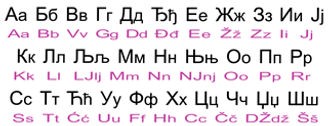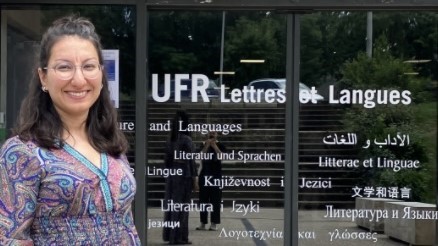Λanguages with a Дifferent AlΦabet * – It’s not all Greek to me anymore.
Καλή μέρα! Добap Дaн! Bonjour! These greetings are not only in three different languages (Greek, Bosnian and French) but also three different alphabets (Greek, Cyrillic and Latin). If you are interested in different-alphabet languages, think that learning a different alphabet would be a fun experience or just enjoy reading about alphabets and languages, this blog is something for you!
My name is Selcen Erten, and I am a PhD researcher at the University of Turku. Being fascinated by all modes of the language phenomenon, I attended to the 5-day course LEARNING Α ΛANGUAGΕ WITH A ДIFFΕRΕNT ALΦABET at the University of Poitiers, France, through EC2U (and also Erasmus+) programme. (For what EC2U programme is, how you can benefit from it and how my EC2U experience was at the University of Pavia, Italy, check out my blog !). This blog is about the University of Poitiers and the course I attended there. I will also share my reflections on learning different alphabets with a focus on Greek and Cyrillic.
Poitiers and the University of Poitiers
Being a 1,5-hour train ride away from Paris, Poitiers is a city in west-central France. It is a serene and picturesque city known for its Romanesque architecture. An excellent example of it is the Roman Catholic church Notre Dame la Grande. Another example is the UNESCO-protected Abbaye de Saint Savin, although it is located a bit further away. Poitiers has a very old tradition as a university centre starting in the Middle Ages. The University of Poitiers was founded in 1431!

Rectoria, Université de Poitiers.
Already in the 16th century, it was considered the second most important university in France. After the French Revolution, the University of Poitiers was refounded and became even more prestigious. Through its history, it has welcomed many famous philosophers and scientists. To name a few, for example François Rabelais, Francis Bacon, Guez de Balzac and René Descartes. Today it serves over 26 0000 students. I was happy to have been to Poitiers with the 5-day language course.
The course “LEARNING Α ΛANGUAGΕ WITH A ДIFFΕRΕNT ALΦABET”
LEARNING Α ΛANGUAGΕ WITH A ДIFFΕRΕNT ALΦABET was organized by the University of Poitiers as a BIP (Blended Intensive Programme) course. BIP means that there were online meetings as well as the actual on-site mobility. For the physical mobility, the organizing team thought of the smallest details from the minute we arrived in Poitiers in terms of practicalities, the courses and the culture trips. As I stayed at the residence on the campus, I also had an opportunity to experience the campus life of Poitiers.
The course lasted for 5 days, on 3 of which we had the Greek course. For the last 2 days, we had the option of choosing between Bosnian and Russian. I went with Bosnian Cyrillic thinking that Bosnian can be a low-context language and I might not have a chance of hearing it as much otherwise. Another reason for my preference was that Bosnian is one of the four languages of BCMS which is Bosnian, Croatian, Montenegrin and Serbian. BCMS is a polycentric language with four mutually intelligible varieties.
My reflections on learning a language with a different alphabet
I think that the issue of learning a language with a different alphabet has two sides: 1) The languages you have acquired and learnt are Latin-alphabet languages, and you have decided to learn another-alphabet language. 2) The language you have acquired is a non-Latin alphabet language, and you have decided to learn a Latin-alphabet language. In any case, I think deciphering different letters is fascinating! As situation 1 is my very case, I will tell about my reflections on it through Greek and Cyrillic alphabets.
Learning languages with different alphabets: Greek alphabet
Alpha, Beta, Gamma … Omega. Greek alphabet is an ancient writing system used to write the Greek language, and it consists of 24 letters. Each letter has a corresponding uppercase and lowercase form as you can see below:

As seen, there are some letters that we are familiar with from the Latin-alphabet languages. While learning how Greek alphabet works, I definitely benefitted from them, but I needed to be careful about the sounds they correspond to. Letter K gives the sound of /k/, but P, behaving differently, gives the sounds of /r/. Letter Y can even be a bit more tricky, because in Turkish and English, for example, it sounds like in yoghurt, but in Finnish it sounds differently like in yliopisto. In Greek, it represents the sound of /u/. It is not always tricky, though. The ortography of some Greek-specific letters give a hint about how they sound. Δ, Σ and Ω are some examples. Any guesses? Right: These letters represent the sounds of /d/, /s/ and /o/, respectively.
Then there is the lower case issue also. Some letters are different depending on their upper and lower case. It is important to be aware of those differences while reading and writing especially if your Latin alphabeted-brain tries to trick you. To make it more challenging, there can also be individual differences of the letters in cursive writing. Cursive writing is a style of handwriting where you write all the letters of a word connectedly without lifting your pen off of the paper. That is one challenge, but the more exposed you get to the alphabet and see different cursive writings, the less the challenge it becomes. Also something I have observed in this course: In reading cursive writing as well as generally learning a different alphabet, the use of universal or international words such as φιλμ, φιλοσοφία and βιβλιοθήκη can be very useful to practice the letters.
Learning languages with different alphabets: Cyrillic alphabet
The Cyrillic alphabet is a writing system used by several languages, and one of them is Bosnian. In fact, Bosnian can be written both in Cyrillic and Latin alphabets (Other language examples that use both scripts are Serbian and Montenegrian).
Below you can see the Bosnian letters in Cyrillic alphabet and Latin alphabet:

With a few exceptions, Cyrillic alphabet for all Slavic languages are quite similar. So if you learn Cyrillic, you can read pretty much all languages that uses the Cyrillic script. In fact, you can use your Cyrillic knowledge even while reading Greek (and vice versa)! Because, Cyrillic alphabet was developed based on the Greek alphabet.
For me, the challenge in the course while learning the Cyrillic alphabet right after the Greek alphabet was the mix-ups. For example, both Greek and Cyrillic alphabets have the letter b, but it represents the sound /v/ in Greek while in Bosnian it can be pronounced as /b/ or /v/ depending on the ‘tails’ on the letter. So, knowing how to read the Greek letters help while reading Bosnian Cyrillic. However, the mix-ups also come in the same package. Still, the mix-ups are rather funny moments, and they show that something nice is happening in your brain!
100 % target language use in the classroom? Oh yes!
Both our Greek teacher and Bosnian teacher used 100 % target language in the classroom! I would not think this could be done in a different-alphabet language at the beginner level, but I experienced myself that it actually works! I observed that it facilitates the learning, as well. Why? Because, I think:
- Classroom can be the only place for the learners to catch the musicality of that language unless they live in the country where the target language is spoken. Even then, the input is tailored to the level of the learners which is not necessarily the case outside of the classroom.
- The teacher’s total use of the target language helps learning greatly, because there are gestures and body language along with the target language, which all support the learning process. Additionally, the deictic nature of the language used in the classroom like “here, this, now, me, you” enables the learners to understand more with a total target language use.
- When the learners understand the bits of the target language, they feel successful, because, come on, learning a different-alphabet language is not a piece of cake! When the learners actually catch the bits of the language, that is the feeling of success! No need to mention the encouraged feeling as a bonus!
- Hearing the target language all the time motivates the learners to actually respond to the teacher, and use the language. It can be very simple things at the beginning like Ναι, Όχι, Ευχαριστώ, εύκολος, δύσκολος and Да, Не, Хвала, лак, Тељко (yes, no, thank you, easy, difficult in Greek and Bosnian Cyrillic, respectively).
Next step… Learning other languages with different alphabets…
I would like to give a fun fact about my home country, Turkey. Turkish is a Latin-alphabet language, but Turkey has 8 neigbouring countries and almost all of them use different alphabets! Greece has Greek alphabets. Bulgaria has Cyrillic albhapets. Georgia has Georgian alphabets. Armenia has Armenian alphabets. Azerbaijan has Latin alphabets. Iran has Persian alphabets. Iraq and Syria have Arabic alphabets. Thanks to this course at the University of Poitiers and the EC2U programme, I can read Greek and Cyrillic now. Along with improving what I have learnt in Greek and Bosnian, my dream is to learn how to read the other alphabets that the neighbours of Turkey use.
I encourage you to participate in EC2U mobilities, as there is a lot to experience in the programme. As for the different alphabets, I hope to have aroused interests in you trying a different-alphabet language. For the courses of different-alphabet languages you can take in Turku, check out the links below. Ευχαριστώ, Хвала, Merci!
Language and Communication Studies | Opinto-opas 2022-2024 (utu.fi)
Turun suomenkielinen työväenopisto (opistopalvelut.fi)
*The title “Λanguages with a Дifferent AlΦabet” was originally used in the BIP course (2021-1-FR01-KA131-HED-000006087-3) organized at the University of Poitiers. I am using the letters Λ, Д and Φ in the title of my blog with their permission.

